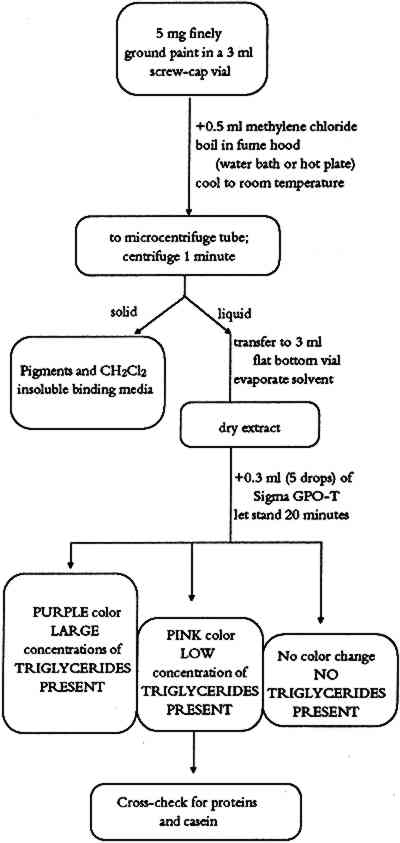BINDING MEDIA IDENTIFICATION IN PAINTED ETHNOGRAPHIC OBJECTSDUSAN STULIK, & HENRY FLORSHEIM
2 TEST FOR TRIGLYCERIDESTriglycerides (TG) used as binding media on ethnographic art objects can be categorized as oils or lards. Chemically, both oils and lards belong to a class of chemical compounds known as esters. Esters are produced when an alcohol and a carboxylic acid undergo a condensation reaction. Vegetable oils are obtained from seeds and nuts of certain plants. Lard is a solid fat prepared by rendering fatty tissue of animals. Both vegetable oils and lards are composed of triglycerides of fatty acids (esters of glycerol and higher saturated or unsaturated carboxylic acids). The number of carbon-carbon double bonds in the triglyceride affect the drying properties of the material. Drying oils contain a large concentration of polyunsaturated fatty acids (especially linolenic acid). Nondrying oils contain only very small amounts of this acid and consist of varying amounts of saturated and mono- or disaturated fatty acids. Lards are composed of palmitin, stearin, and olein (triglycerides of palmitic, stearic, and oleic acid, respectively). Hydrolysis of oils and lards produces glycerol (glycerine) and free fatty acids. The fact that glycerol is an integral part of all vegetable oils and animal lards serves as a basis for a laboratory proof of these materials in paint layers. 2.1 METHODThe sample is dissolved in hot methylene chloride. Insoluble material is removed by centrifugation. The methylene chloride solvent is evaporated, and the presence of glycerol in the sample is determined by an enzymatic test. Triglycerides are first hydrolyzed by lipoprotein lipase to glycerol and free fatty acids.
Glycerol is then phosphorylated by adenosine triphosphate [ATP] forming glycerol-I-phosphate [G - 1 - P] and adenosine-5-diphosphate [ADP] in the reaction catalyzed by glycerol kinase [GK].
G - 1 - P is then oxidized by glycerol phosphate oxidase [GPO] to dihydroxyacetone phosphate [DAP] and hydrogen peroxide [H2O2].
Hydrogen peroxide catalyzes the reaction of 4-aminoantipyrine [4-AAP] with sodium N-ethyl-N-[3-sulfopropyl]-m-anisidine [ESPA] to form a quinoneimine dye.
A pink to purple color of the quinoneimine dye indicates the presence of triglycerides in the analyzed sample (McGowan et al. 1983; Barham and Trinder 1972). 2.2 PROCEDUREThe flow chart for the triglyceride test is shown in figure 1. A finely ground paint
TABLE 2 BINDING MEDIA TEST REAGENTS 2.3 COMMENTSPaint samples containing drying oils, animal fat (lard), egg yolk, or unpurified milk casein give a positive color. The color intensity of the test varies with concentration of triglycerides in the sample. Egg yolk and whole milk (source of casein) contain some triglycerides and may give a very weak positive test. If weak tests are obtained, the sample should be tested for presence of protein and phosphorus. Paint samples treated with glycerine or with material containing glycerine might also give a positive test for triglycerides even without any triglycerides present. |




